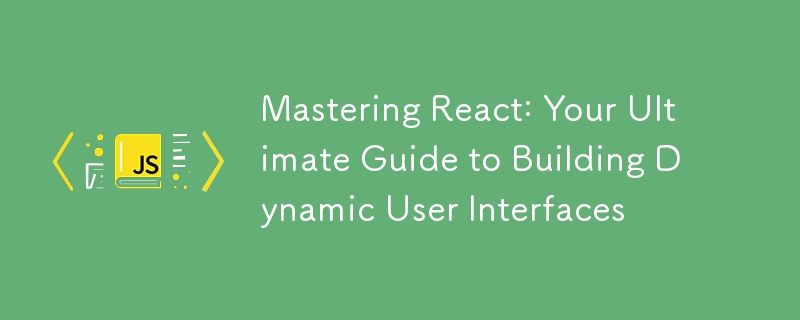Home >Web Front-end >JS Tutorial >Mastering React: Your Ultimate Guide to Building Dynamic User Interfaces
Mastering React: Your Ultimate Guide to Building Dynamic User Interfaces
- Barbara StreisandOriginal
- 2024-10-31 08:21:30673browse

-
What is React?
- A JavaScript library for building user interfaces, particularly single-page applications.
- Developed and maintained by Facebook.
- Enables the creation of reusable UI components.
Core Concepts
1. Components
- Functional Components: JavaScript functions that return React elements. Can use hooks for state and lifecycle features.
- Class Components: ES6 classes that extend React.Component. Used for more complex logic and state management before hooks were introduced.
2. JSX (JavaScript XML)
- A syntax extension that allows you to write HTML-like code within JavaScript.
- JSX is transformed into React elements.
- Example:
const element = <h1>Hello, world!</h1>;
3. Props
- Short for "properties," props are used to pass data from parent components to child components.
- Props are read-only and help in making components reusable.
- Example:
<MyComponent title="Welcome" />
4. State
- A built-in object that allows components to create and manage their own data.
- State changes trigger re-renders of the component.
- Use the useState hook for functional components:
const [count, setCount] = useState(0);
5. Lifecycle Methods
- Class components have lifecycle methods (e.g., componentDidMount, componentDidUpdate, componentWillUnmount) to manage side effects.
- In functional components, use the useEffect hook to achieve similar functionality.
6. Event Handling
- React uses camelCase syntax for events.
- Events can be passed as props to components.
- Example:
<button onClick={handleClick}>Click me</button>
Advanced Concepts
1. Hooks
- Functions that let you use state and other React features in functional components.
- Common hooks include:
- useState(): For state management.
- useEffect(): For side effects (data fetching, subscriptions).
- useContext(): For accessing context.
2. Context API
- A way to share values (like themes or user information) between components without having to pass props down manually at every level.
- Create a context with React.createContext() and use Provider and Consumer.
3. React Router
- A library for routing in React applications.
- Allows for navigation between different views and supports nested routes.
- Example:
<BrowserRouter>
<Route path="/about" component={About} />
</BrowserRouter>
4. State Management Libraries
- For larger applications, consider using state management libraries like:
- Redux: Predictable state container for JavaScript apps.
- MobX: Simple, scalable state management.
- Recoil: For managing state in React applications.
Performance Optimization
- Memoization: Use React.memo for functional components to prevent unnecessary re-renders.
- useMemo & useCallback: Hooks to memoize values and functions, improving performance in complex components.
Testing
- Use libraries like:
- Jest: A JavaScript testing framework.
- React Testing Library: For testing React components with a focus on user interactions.
Conclusion
- React is a powerful library that promotes a component-based architecture, making it easier to build and maintain user interfaces.
- Understanding its core concepts, hooks, and best practices is essential for effective React development.
The above is the detailed content of Mastering React: Your Ultimate Guide to Building Dynamic User Interfaces. For more information, please follow other related articles on the PHP Chinese website!
Statement:
The content of this article is voluntarily contributed by netizens, and the copyright belongs to the original author. This site does not assume corresponding legal responsibility. If you find any content suspected of plagiarism or infringement, please contact admin@php.cn
Previous article:How to Dynamically Set Properties in Nested JavaScript Objects?Next article:How to Dynamically Set Properties in Nested JavaScript Objects?
Related articles
See more- An in-depth analysis of the Bootstrap list group component
- Detailed explanation of JavaScript function currying
- Complete example of JS password generation and strength detection (with demo source code download)
- Angularjs integrates WeChat UI (weui)
- How to quickly switch between Traditional Chinese and Simplified Chinese with JavaScript and the trick for websites to support switching between Simplified and Traditional Chinese_javascript skills

